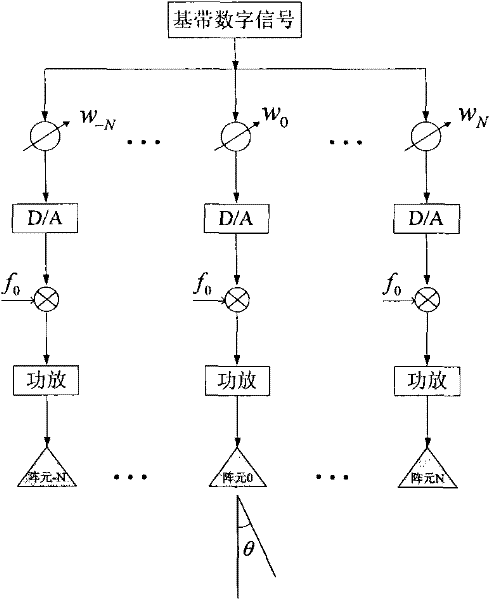Airborne three-dimensional synthetic aperture radar imaging system based on transmitted beam scanning
A synthetic aperture radar and transmitting beam technology, applied in the radar field, can solve the problems of poor timeliness, complex imaging processing, and large amount of echo data, and achieve the effects of strong timeliness, low complexity, and small amount of received echo data.
- Summary
- Abstract
- Description
- Claims
- Application Information
AI Technical Summary
Problems solved by technology
Method used
Image
Examples
Embodiment 1
[0041] The present invention is an airborne down-looking three-dimensional synthetic aperture radar imaging system based on transmitting beam scanning, see figure 1 , the system includes: a radar transmitter, a phased array antenna, a radar receiver and an imaging processor, wherein the radar transmitter generates a beam and transmits it to each transmitting array of the phased array antenna installed in the vertical direction of the flight plane The radar echoes of the emitted beams irradiating the target scene are received one by one synchronously by the receiving elements of the phased array antenna, and sent to the radar receiver for echo data sampling, and then sent to the imaging processor To complete the imaging processing of the echo data.
[0042] The beam generated by the radar transmitter of the present invention is a beam generated by transmitting beamforming technology, and the schematic diagram of the principle of transmitting beamforming can be found in figure...
Embodiment 2
[0063] System constitution of the present invention is with embodiment 1. Refer to image 3 , the phased array antenna of the present invention is placed on the wing of the aircraft, and the placement direction is perpendicular to the flight direction of the aircraft. The phased array antenna can be uniformly densely distributed or sparsely distributed to reduce system hardware costs. For the convenience of analysis, the phased array antenna in this example adopts a uniform and dense array, and the single receiving element in the phased array antenna array is a receiving and transmitting element, which can be selected as any element in the phased array antenna One array element, but due to geometric symmetry, its best position is in the center of the phased array antenna array. The vertical heading dimension D of the array element a It should be satisfied that its vertical heading beam width is slightly larger than the vertical heading mapping bandwidth W y , which satisfies...
Embodiment 3
[0068] The present invention is also an airborne down-looking three-dimensional synthetic aperture radar imaging method based on transmitting beam scanning, the method is implemented on an airborne down-looking three-dimensional synthetic aperture radar imaging system, see image 3 , the present invention is a multi-transmission and single-reception system. When transmitting, all array elements of the phased array antenna work simultaneously; when receiving, only a single array element works. The specific steps include:
[0069] Step 1. The radar transmitter uses the transmit beamforming technology to weight the signals of different transmit channels through preset weighting factors to form narrow beams with different preset directions in the vertical direction. See figure 2 ;
[0070] Step 2. The phased array antenna transmits the narrow beams generated by the radar transmitter one by one, scans the vertical direction with narrow beams at each azimuth time, and finally reali...
PUM
 Login to View More
Login to View More Abstract
Description
Claims
Application Information
 Login to View More
Login to View More - R&D
- Intellectual Property
- Life Sciences
- Materials
- Tech Scout
- Unparalleled Data Quality
- Higher Quality Content
- 60% Fewer Hallucinations
Browse by: Latest US Patents, China's latest patents, Technical Efficacy Thesaurus, Application Domain, Technology Topic, Popular Technical Reports.
© 2025 PatSnap. All rights reserved.Legal|Privacy policy|Modern Slavery Act Transparency Statement|Sitemap|About US| Contact US: help@patsnap.com



